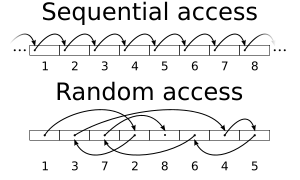Sequential access facts for kids
Sequential access is a way of getting to information or items one after another, in a specific order. Imagine reading a book from the very first page to the last. You have to go through each page in order to get to the next one. This is different from random access, where you can jump straight to any page you want, like using a book's index to find a specific topic.
Sometimes, sequential access is the only way to get to data. For example, old magnetic tapes store information this way. You have to fast-forward or rewind through the tape to find what you need. Other times, it's a good choice if you want to process all the information in the order it was saved.
What is Sequential Access?
In computers, sequential access means that data is read or written in a fixed, step-by-step order. Think of a line of people waiting for a ride. They have to get on one by one. You can't just pick someone from the middle of the line to go next.
This method is common for certain types of storage. For example, when you save a document, the computer might write the information in a sequence. When you open it later, it reads that information back in the same order.
Sequential Access in Data Structures
In computer science, a data structure is a way of organizing data. Some data structures are designed for sequential access. A good example is a linked list. Imagine a chain of paper clips, where each clip holds a piece of information and points to the next clip. To find information on the fifth clip, you have to start at the first and follow the chain through the second, third, and fourth clips.
This means that finding something specific in a sequential data structure can take more time if it's far down the line. For example, if you want to find the 100th item, you might have to look at the first 99 items before you get to it. This is why some fast computer methods, like binary search, don't work well with sequential access because they need to jump around quickly.
However, other methods, like mergesort, work perfectly fine with sequential access. They don't need to jump around; they just process data in order.
See also
 In Spanish: Acceso secuencial para niños
In Spanish: Acceso secuencial para niños
- Direct-access storage device
- Queued sequential access method


